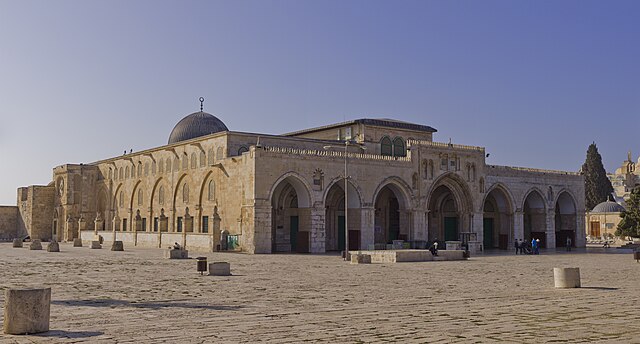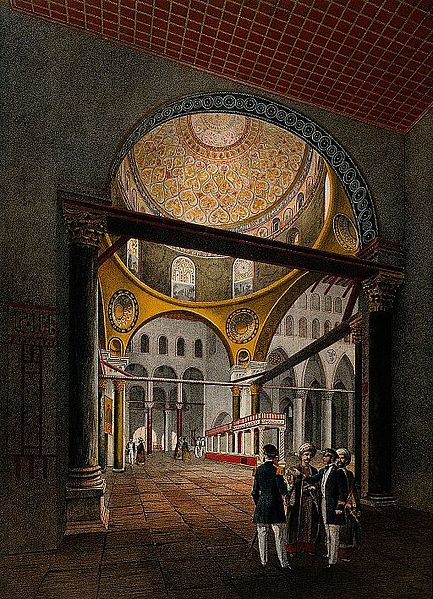The Aqsa Mosque, also known as the Qibli Mosque or Qibli Chapel, is the main congregational mosque or prayer hall in the Al-Aqsa mosque compound in the Old City of Jerusalem. In some sources the building is also named al-Masjid al-Aqṣā, but this name primarily applies to the whole compound in which the building sits, which is itself also known as "Al-Aqsa Mosque". The wider compound is known as Al-Aqsa or Al-Aqsa mosque compound, also known as al-Ḥaram al-Sharīf.
Al-Aqsa Mosque
The mosque is situated at the Southern end of the Haram al-Sharif
The mosque along the southern wall of al-Haram al-Sharif
A 19th-century chromolithograph of the mosque's interior. The mosaic designs on the drum of the dome, the pendentives, and the archway in front of the mihrab date from the mid-11th-century Fatimid reconstruction
Al-Aqsa or al-Masjid al-Aqṣā is the compound of Islamic religious buildings that sit atop the Temple Mount, also known as the Haram al-Sharif, in the Old City of Jerusalem, including the Dome of the Rock, many mosques and prayer halls, madrasas, zawiyas, khalwas and other domes and religious structures, as well as the four encircling minarets. It is considered the third holiest site in Islam. The compound's main congregational mosque or prayer hall is variously known as Al-Aqsa Mosque, Qibli Mosque or al-Jāmiʿ al-Aqṣā, while in some sources it is also known as al-Masjid al-Aqṣā; the wider compound is sometimes known as Al-Aqsa mosque compound in order to avoid confusion.
Aerial view of the Al-Aqsa mosque compound atop the Temple Mount
Southwest qanatir (arches) of the Al-Aqsa. Qubat al-Nahawiyya is also partially visible to the right.
The main mosque prayer hall along the southern wall of Al-Aqsa
A 19th-century chromolithograph of the prayer hall's interior. The mosaic designs on the drum of the dome, the pendentives, and the archway in front of the mihrab date from the mid-11th-century Fatimid reconstruction






